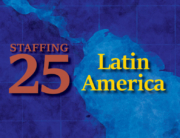Forget conspiracy theories; the shortage of quality STEM workers is no myth. It’s taking 26 days on average to fill tech positions, and the competition for skilled talent pushed up salaries 7.7% from 2014 to 2015, according to the Dice Salary Survey. Contract workers saw an average 5% year-over-year increase, reaching an average of $70.26 per hour.
Tapping the global talent pool may seem like a practical way to increase inventory, but the process for sponsoring foreign workers is complex, expensive and fraught with risk.
“The H-1B visa approval process has become extremely adversarial over the past five years due to the political climate,” notes Michael Hammond, an immigration attorney with Hammond Law Group. “Government agencies are trying to dissuade employers by making sponsorship as difficult as possible.”
Still, Hammond projects a 99.9% success rate for staffing firms willing to put up a fight and persevere. If direct recruitment isn’t an option, there are other ways to leverage the talents of non-immigrant workers.
Here’s a look at the primary ways for staffing firms to engage workers on H-1B visas and the pros and cons of each option.
Option 1. Overseas Workers
Since the issuance of the Neufeld Memo in 2010, sponsoring H-1B visa workers and placing them at third-party worksites requires client involvement and cooperation, and hefty investments in specially trained staff and legal counsel. Generally speaking, staffing firms need strong contractual relationships and a steady flow of orders from one or two major clients to make sponsorship worthwhile.
Advantages. Staffing firms that sponsor foreign workers are able to fill more contract requisitions for professionals with in-demand skills such as .NET and Java, according to Tim DePotter, director of quality and operations at eTeam.
“Contractors on H-1B visas are looking to enhance their résumés, so they’re willing to relocate for assignments in remote locations that are hard to fill,” DePotter notes. “And clients with difficult requirements need a trusted partner to handle the red tape.”
Moreover, helping a client achieve diversity goals or communicate with offshore teams through a planned and proactive infusion of multicultural and multilingual professionals can reposition a transactional staffing vendor as a strategic business partner.
If a contractor and client click — and the client agrees to sponsor the contractor’s green card application process — staffing firms can charge a fee when he or she converts to regular full-time status.
Disadvantages. Sponsoring an H-1B visa worker costs around $5,000, but since the visas are valid for up to six years, this option offers the biggest potential upside for staffing firms that identify candidates who commit to working in the US for a few years.
The burden of proof falls on staffing firms to establish employer-employee relationships for workers assigned to third-party clients. This is an arduous task, made even more difficult by government agencies that put staffing and outsourcing firms responsible for displacing American workers at Southern California Edison and Disney in the same bucket.
“The folks at the U.S. Citizenship & Immigration Services basically don’t believe a word you say,” Hammond explains. “The added scrutiny is making the process more cumbersome.”
For instance, assuming your firm wins the visa lottery on April 1, you must provide written confirmation from the end client (known as a Neufeld letter) that an assignment for a qualifying STEM position will be available when the contractor arrives on Oct. 1. In addition, you may need to submit a copy of the job description, service agreement, scope of work, performance review and client organizational chart to demonstrate the beneficiary’s supervisory chain.
Also, staffing firms must pay H-1B visa workers prevailing wages whether they work or sit on the bench, and you’ll have to pay for a trip home if terminated or idle employees are unable to find suitable employment.
“The benching rules can be challenging for firms with thin margins,” notes Mark Roberts, CEO of TechServe Alliance. “That’s why it’s not a good idea for any staffing firm to become dependent on H-1B workers.”
Finally, non-immigrant workers are entitled to the same benefits as US workers, and they can quit or change jobs at any time. Some firms try to discourage defections by requesting promissory notes or six-month notice periods, but enforcement may be difficult if push comes to shove.
Option 2. Recruiting Current Visa Holders
Transferring a current visa holder to your payroll is faster, so it tends to be the better option for tier two suppliers and staffing firms that service midsize companies.
Advantages. You can recruit and hire a current visa holder at any time as long as your firm is willing to provide sponsorship. It’s not necessary to obtain permission from the previous employer; your firm must simply file a new H-1B petition with the USCIS and meet the rigorous eligibility and compliance requirements.
Best of all, the contractor can start work as soon as the paperwork is received, and you don’t have to incur relocation or travel costs if you recruit and hire locally.
Disadvantages. While speedy placements benefit clients with pressing needs for talent, the practice can backfire because the contractor must stop work immediately if their application is denied.
“Sponsorship carries responsibilities,” Roberts says. “Your reputation and relationships are on the line because the client is trusting that all the paperwork is in order.”
In fact, the USCIS has beefed up its anti-fraud auditing efforts amid abuse allegations. Plus, the same $5,000 costs apply to a transfer as an initial H-1B filing, but the amortization period is shorter and the other rules of sponsorship still apply. Therefore, it’s important to consider the length of the assignment, your ability to reassign a contractor to other clients, and his or her remaining visa eligibility when calculating the return on a potential transfer.
Option 3. Subcontracting Visa Holders
If your recruiting team occasionally needs help sourcing purple squirrels, subleasing a worker from a competitor or firm that specializes in H-1Bs and divvying up the margin might be the way to go.
Advantages. Under the arrangement, the worker remains on the payroll of the sponsoring firm so there are no hefty processing costs or downtime. However, your client may need to provide a Neufeld letter and work order if the new work location has to be certified.
Disadvantages. Obviously, margins tend to be lower under split fee arrangements, and you may inadvertently open the back door to a competitor unless solicitation activities and poaching are prohibited via a subcontracting agreement.
“Although the sponsoring organization is legally on the hook for vetting the candidate, subcontractors incur a reputational risk,” Roberts says. “It might be a good idea to conduct reference checks or verify the candidate’s certifications and degrees before assigning a subcontractor to your client.”
Option 4. Recruiting Foreign STEM Graduates
If you’re looking for a low-cost, no-hassle way to increase your talent pool, recruiting students and graduates of STEM programs at US universities is the best deal of all.
Advantages. Some 560,000 foreign students can now temporarily work in STEM-related fields during and after their studies, thanks to a 24-month extension in the Optional Practical Training program that took effect on May 10.
“Graduates can now work in the US for a total of 36 months,” Hammond says. “You don’t have to complete transfer paperwork between assignments or follow benching rules. Plus, you get three shots at the lottery for every graduate you hire.”
Disadvantages. Obviously, new grads may not be able to handle senior positions where clients need an experienced pro who can hit the ground running, but they can be a valuable addition to your contract workforce.
“Some companies like to try out engineering grads on a temporary basis first and convert them to full-time status later,” DePotter says. “They see it as a viable strategy for accessing the global talent market.”







